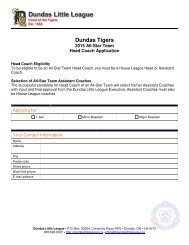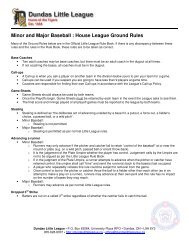Rules of Play - Dundas Little League
Rules of Play - Dundas Little League
Rules of Play - Dundas Little League
You also want an ePaper? Increase the reach of your titles
YUMPU automatically turns print PDFs into web optimized ePapers that Google loves.
- 5 -<br />
3-10. Protesting a game. There are no <strong>of</strong>ficial protests in T-ball. A call may be questioned but the<br />
umpire¹s judgment will stand. Any conflicts in the interpretation <strong>of</strong> rules will be addressed after<br />
the game by the division convener in a constructive fashion but will not affect the outcome <strong>of</strong> a<br />
game itself. It is an instructional level <strong>of</strong> baseball for all involved.<br />
4. <strong>Play</strong>ing <strong>Rules</strong><br />
4-1. To begin the game, the plate umpire shall instruct the home team to take their positions in<br />
the field, place the tee <strong>of</strong> batting teams choice on home plate and call play for the first batter <strong>of</strong><br />
the <strong>of</strong>fensive team.<br />
4-2. The batter becomes a base runner when -<br />
a) He hits the ball hard enough to cross the playing line in fair territory.<br />
b) The catcher interferes with him while he is attempting to hit the ball. The batter is awarded<br />
first base, the ball is dead and no runners may advance, except those forced by the batter<br />
becoming a base runner. In the event that the batter, in spite <strong>of</strong> the interference, hits the ball<br />
fairly and reaches any base safely and all other runners have advanced at least one base safely,<br />
then the interference is disregarded.<br />
c) In the case <strong>of</strong> catcher interference on the last batter, while he is attempting to hit the ball, the<br />
ball is dead, no runners may advance and the last batter is allowed to continue his turn at bat,<br />
with the same count.<br />
d) In the event, the last batter in spite <strong>of</strong> the catcher interference, hits the ball fairly and reaches<br />
home plate safely, the ball is alive and the catcher interference is disregarded.<br />
e) However, in all cases <strong>of</strong> catcher interference, the <strong>of</strong>fensive manager, has the option <strong>of</strong><br />
accepting or refusing the catcher interference.<br />
4-3. A Batter is Out when -<br />
a) His fair, dead hit or foul ball is caught by a member <strong>of</strong> the defensive team. The ball is alive<br />
and in play until time is called.<br />
b) He hits the ball illegally, ball is dead and runners may not advance.<br />
c) He has three strikes called on him, ball is dead and runners may not advance.<br />
4-4. A base runner is out -<br />
a) on a force play<br />
b) when he is tagged while not touching a base.<br />
c) when running more then 3ft <strong>of</strong>f his baseline to avoid a tag<br />
d) when he is hit by a fair batted ball, either on or <strong>of</strong>f his base, before it has touched or gone





